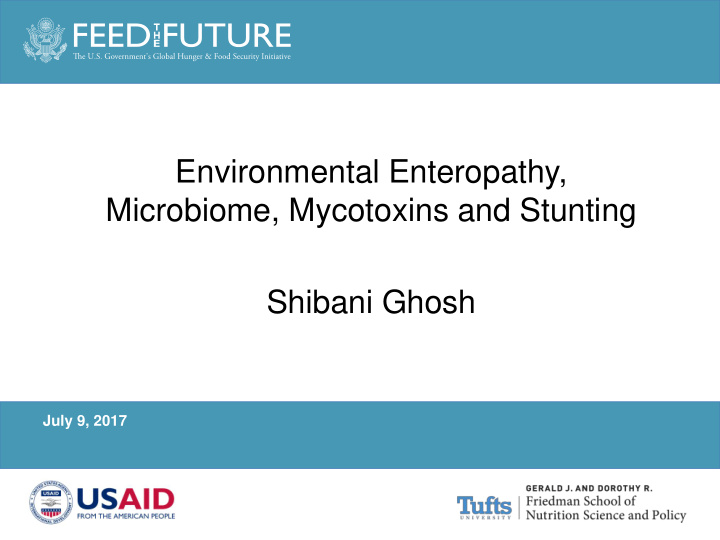



Environmental Enteropathy, Microbiome, Mycotoxins and Stunting Shibani Ghosh July 9, 2017 Photo Credit Goes Here
World Health Assembly Global Nutrition Targets- 2025 and Global Monitoring Framework for Prevention and Control of NCDs http://ebrary.ifpri.org/utils/getfile/collection/p15738coll2/id/130354/filename/130565.pdf
Prendregast and Humphrey, 2014
ENVIRONMENTAL ENTEROPATHY • Sub-clinical disorder of the small intestine • Phenomenon of impaired intestinal function rather than a clinical condition • Environmental exposure to infections and enteric pathogens- early in life- gut in perpetual state of low level inflammatory immune stimulation • Over time- disruption of normal intestinal function, alterations in mucosal lumen surface structure, compromise in gut capacity to absorb nutrients
MICROBIOME • The intestinal microbiota is an ecosystem of gut microbes • helps to modulate nutrient harvesting from the diet, mucosal inflammation, and the immune response in the gut
6
ENVIRONMENTAL ENTEROPATHY (EED) LM Test (Lactulose mannitol dose and excretion in urine) EED testing in Uganda (lactulose:mannitol): 385 children 12-16 m . Median L:M score 0.27: 21% no EED, 58% moderate, 22% severe . Infants with clean water better L:M scores (P<0.050). If goats/sheep inside home , significantly worse L:M (P<0.050). L:M significantly higher if infants stunted or wasted at 6-9m (i.e. prior to L:M test). Fecal markers- myeloperoxidase, npeoterin, AAT (alpha 1- antitrypsin), inflammatory markers- cytokines, interleukins, immunoglobulins, calprotectin, zonulin Blood markers- serum flagellin, serum citrulline, serum lipopolysaccharide Fecal MRNA
Malnourished Children have less diverse, different gut microbiomes Bacteria Shared With Animals 8
Science 339:548-554. 1 February 2013 • 317 Malawian twins studied first 3 years of life • 50% both well nourished; 43% discordant (one well, one malnourished); 7% both were malnourished. • Both twins in discordant pairs received RUTF, a therapeutic food. Gut microbiomes (MB) studied: RUTF → transient Then… MB improvement.
MICROBIOME AND STUNTING • Less diverse gut microbiota are associated with stunting severity • Increase in the relative abundance of Acidaminococcus sp. associated with lower future linear growth in Malawi and Bangladesh
MICROBIOME AND INTESTINAL FUNCTION • In EED, reduced intestinal barrier function enables bacterial translocation to occur, leading to chronic systemic inflammation, which is associated with malnutrition (acute and chronic) • Increase in glutamate fermentation • Glutamate – important precursor for synthesis and metabolic recycling of other amino acids (e.g. arginine) • Contributes to epithelium restitution, preserves barrier function, attentuates intestinal tissue damage
1. 2. 3. LE Smith et al Adv Nutrition 2012 Aflatoxin damage mimics EE 13
CONCLUSION • Mechanistic pathways from contamination/ingestion of contaminants such as aflatoxins, alterations in microbiome and recurrent infections leading to inflammation seem to be similar • Implementing the 10 Lancet interventions at 90% coverage reduces stunting by only 20% • Impacts of EED and poor microbiome could negate any gains made in program implementation
U.S. GOVERNMENT PARTNERS
www.feedthefuture.gov
Recommend
More recommend